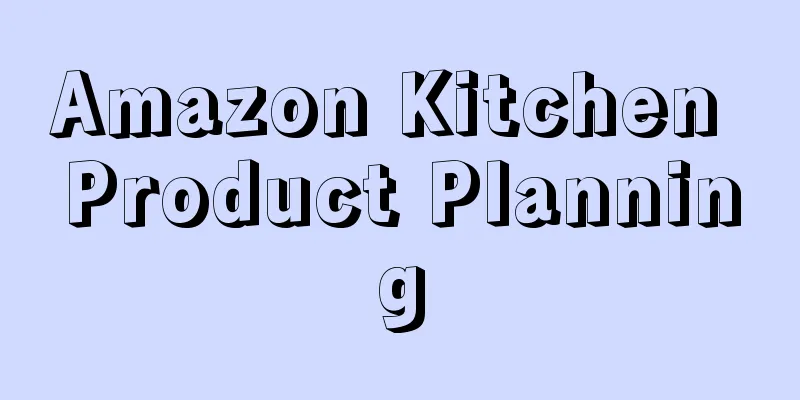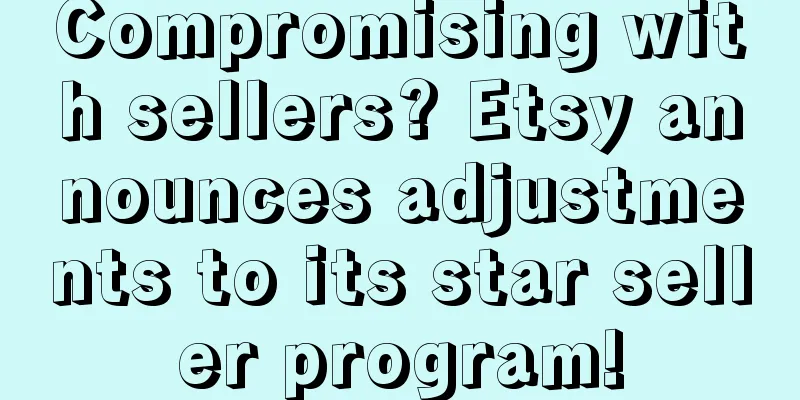Is product selection a gamble? Let’s talk about how to select good products suitable for Amazon operations. I hope to get more and better suggestions...

|
My C position In the past work process, I often encountered this situation: Development said that the operation skills were not good enough, and the operation said that the development product was too bad. It seems that development and operation are born to be a pair of enemies. For a long time, most companies have separated operations and development, not participating in each other's work, and even deliberately isolating information to prevent one person from becoming proficient in both and starting a business. This is due to historical reasons. This has resulted in operations being unfamiliar with product development skills, and being unable to choose the right product based on their own skills, and can only find the direction through constant trial and error. If operations do not know how to select products, it will be a hazy gamble. Gambling is probabilistic, and generally speaking, the probability of success is not very high. 1. Relationship between Operations and Development I have a point of view: development is a preview of operations, and operations are the realization of development. The two complement each other. The two positions need to work closely together to create value, but we often blame each other, which is wrong. At the same time, I have always advocated that operations should learn how to select products, which is very important for a qualified operation. Because the capabilities of each operation are actually different, we all have the highest probability of success when we do things within our capabilities. 2. Two types of operational capabilities Let's talk about operational capabilities first. I divide capabilities into two parts: one is general operational skills, and the other is the accumulation of operational experience in specific categories. Would anyone say there is a difference between the two? Yes, general operational skills are what is often said in the market, such as how to write listings, how to edit pictures, and how to run advertisements; category experience accumulation is the accumulation of product knowledge, how to write listings for this type of product, and how to run advertisements for this type of product. So, are people with strong general abilities more likely to succeed in a specific category? In theory, yes; but as more and more sellers delve into categories and become more specialized, this theory is hard to say. I have seen an operator who has built BS in multiple categories fail to do as well as an ordinary operator in a new category. It seems that people who delve deeply and have achieved results and accumulated experience are gaining more and more advantages. Therefore, it is not about whether a certain operation is good or not. It is more accurate to say whether a certain operation is good in this category. It is inaccurate to talk about operation ability without considering the category. On the other hand, we should not be obsessed with operation masters. If we cross categories, we should be careful. The topic has gone too far, so let's get back to the main topic. The ultimate goal of individuals and companies is to be able to make stable profits, and the operation will get generous commissions, and the company will also benefit. Therefore, the ultimate goal of operation is to make profits, and the basis of profit is to choose good products that suit you. So how do you select good products from the perspective of operation? In other words, what kind of products are good products for operations? 3. About the selection of categories (1) Prioritize products that are familiar and have achieved success. Copying is the fastest method with the highest success rate. Of course, some people will point out uncertain factors such as the passage of time, first-mover advantage, and system algorithms, but the same is true for other products. At least copying reduces variables and increases the probability of success. There are also people who think they are gifted and have extraordinary talents, and always want to blaze a unique path. This is undeniably worth promoting, but in the early stages it is recommended that you follow a safe path, because when various new things come out, the education cost is extremely high, and it takes time for people to adapt from familiar habits. It is possible that you will not be able to wait for that day. (2) Modify or make micro-innovations based on the original successful product. This type of product may be the best choice. Since there is a deep understanding of the original product and a large amount of customer feedback as a basis, adding some new popular elements or functions/performance can greatly increase the probability of success. Perhaps it is one of the best choices. Differentiation avoids direct conflicts (such as price issues) and is equivalent to iteratively upgrading the original product. There is no need to educate customers, and the acceptance rate is higher. (3) The next step is to choose similar products or peripheral products. These products can serve as reference for familiar products and have a higher chance of success than unfamiliar products. However, compared with familiar products, they still increase risks and there may be some unknown pitfalls to step into. (4) How to choose categories that you are not familiar with? You can only judge the probability of profitability, which requires research on CPC, unit price, conversion rate, return rate, and less competitive data. The conversion rate may not be accurate and can only be roughly estimated. In the most extreme case, when all the ads are flyers, can you make a profit? If you can make a profit, then there is a high probability that the product is feasible. In addition, when choosing a category, don't just focus on a small category. Consider the scalability and relevance of the category so that the product does not become narrower and narrower. For example, scenario-based and serialized thinking can prevent you from feeling that you have no products to make after making one or two. Try to have a preliminary plan for these before entering the category. 4. Determine the selection criteria for specific products under the category (1) You can promote variants, iterative products, and derivative products of stable and profitable products yourself. This method has the highest probability of success because you have already experienced the product promotion process (and may have experienced it many times) and are familiar with the methods and rhythm of listing presentation and product promotion. But at the same time, you must clearly distinguish what your success factors are, whether it is difficult to replicate, what changes have taken place in the current competitive environment, and how to successfully promote products. (2) Go through the steps in point (4) above to see how likely you are to make a profit. Try to choose products with a higher unit price, lower CPC, higher CVR, and lower return rate. You can get a rough idea of the intensity of competition by dividing the market search volume by the number of sellers and comparing it with the situation of your previous successful products. (3) Differentiation: Products with obvious differentiation are preferred, especially those with differentiation in appearance and function. If both are present, the conditions for sufficient differentiation are basically met. Differentiation is not random or weird. It is best if it is evolved from best-selling models (clear competitors) and has data support. (4) The capacity should be a little larger. Look at the approximate sales volume and amount of competitors and estimate the situation of your own products. If the capacity is too small, you should give up because the input-output ratio is not high. (5) Clearly benchmark competitors. Why do we need to benchmark best-selling products? Because best-selling products have passed the market test, benchmarking them is more likely to gain market recognition, which is equivalent to saving some time and costs for testing. If there is no clear benchmark, then we can only try and make mistakes in small quantities. Again, copying is the fastest and most successful method, no doubt about it. (6) Trend judgment, choose products with an upward trend. Lei Jun said: There are many people who are more hardworking and smarter than you, but only a few of them succeed. Only those who know how to go with the flow can succeed. I won’t say much about this. It is difficult for an individual to stop a trend. Going with the trend is the right path. (7) Risk assessment: Patents, bad reviews, returns, low conversion rates. I won’t go into detail about these, as they are relatively simple. I would also like to mention that you should not chase hot topics. Many people choose products because they like to see a new hot product come out, and then they follow the trend. As a result, they end up with a lot of inventory and have to exit at a loss. Avoiding risks is actually far more important than profit. Success is not about being good at taking risks, but being good at controlling risks. We should try to avoid risks on the product side, and things will go much more smoothly later. Big risks are vetoed, especially big deterministic risks, such as patent infringement, which should not be touched. Products with very poor reviews also fall into this category. Don’t think about making up for the reviews later, as the risk is extremely high. A gentleman should not stand under a dangerous wall. Try to stay away from risks. Of course, for some products with small risks or unknown risks, if you really want to do it, then try a small amount of trial and error, and failure will not affect the overall situation. The above is my personal understanding, I hope it will be helpful to everyone, and at the same time I hope to get more and better suggestions. "Wonderful Reply" Fortunately, I have a lot of support and I don't doubt myself to the end. I also have a lot of friends around me who recognize and encourage me. When I express some opinions on the Zhiwubuyan forum, I always get positive feedback from everyone. This is very important, and it is also true in our product selection and operation. Especially in new categories, try to reduce the time and cost of the market to give positive feedback, and you will have more motivation and courage to do it. Regarding whether operations should be deeply cultivated in categories, I actually have a slightly different view. Uncle also mentioned that we should take advantage of the situation. The ecology of some categories determines that "if you choose the wrong category, you will work hard to lose, and if you choose the right category, you will win easily." In the past, I found in exchanges with many friends that the level of operation is really not the key to determining whether you can make a profit. After reading too many stories, I resolutely cut off the categories that formed the "advantage trap" in the past, and then look at each category from the perspective of running a business. Therefore, I have grown a lot during this period. Sometimes I think that the reason why there are so many contradictions between development and operation in this dimension is probably because we are stuck in our own work and thinking. If we use a business perspective, or a boss's perspective to look at any product, would it be different?
First of all, I think the first step is to change the mindset of operations development. If you continue to use the mindset of operations to develop, you will find that you are getting closer and closer to the data, but farther and farther away from the product, and in-depth understanding and research of the product happens to be the key to success; Secondly, after you have the initial development thinking, the choice of category will be a big challenge. In this process, you will experience a lot of confusion because you don’t know how to choose a category. In the final analysis, choosing a category is choosing a business. When we work in the company, we are all impressed by the boss’s superior insight, and we can’t help but ask in our hearts, huh? How did you think of doing this category? The implication is that I could not think of this category anyway. A successful category (track) selection can comprehensively reflect a person’s soft power (insight, judgment, vision, information, etc.); Finally, when you choose a category and are ready to make a big move, you will find that you cannot make a good product. Personally, I don’t have any good ideas. Not having good ideas is like having a desert mind. When you try your best to get a spring of fresh water, you find that you are powerless. Only you can understand the feeling of powerlessness. Conclusion: In our industry, we all know that 70% of the work is product selection and 30% of the work is operation. Every operator wants to have the ability to develop, but it is easier said than done. The road to development is long and arduous, and I will continue to explore. I hope that we can all find a field where we can shine.
I believe everyone has seen and tried quantifiable data and methods, but product selection seems to involve some metaphysics. It depends on the feeling of the product and the market, which does require a sense of smell and a feeling. For example, this feeling is like photography. Others have taught me how to open the camera's nine-square grid and put the person at 1/3 and the scenery at 2/3, but the photos I took are just a little bit lacking in feeling. Or you get the feeling in a photo, but can't get the same feeling in the next photo or scene? It's like a chef sprinkling salt. Everyone knows it's a little, but how to sprinkle it. A little bit of chives and a little bit of tomato scrambled eggs are different. The same way of cooking a dish will have a little less taste. I think the key is whether you can get this feeling? And how to get this feeling. In fact, it is possible to obtain it. The way to obtain it is to choose, experience, and try. If it is not innate, then it is the feeling brought by muscle experience. Keep choosing and trying to get this feeling of selecting products. At the same time, this feeling does not mean jumping out of the visualized data and relying entirely on intuition, nor does it guarantee 100% success in product selection. Instead, it increases the success rate of product selection after the data. The top 100 products are selected through data → the top 10 are selected based on the feeling of the market and products → a few profitable links are obtained after the products are put on the shelves and operated.
In fact, you need to consider the "profit potential" of the selected category. If you find high-profit products when doing market research at the beginning, This is a trap product selection, or the rotation of seasonal products. By the time you enter the market, the products are already in surplus or out of season, and you can only clear the inventory. Therefore, more consideration should be given to the balance between market capacity and profit potential. At the same time, the startup capital determines the price range and advertising investment you should choose.
So I don’t know if it’s because my personal ability is not enough, or there are too few products to choose from on the market. I still need to learn more.
|
Recommend
What is Yibang International Logistics? Yibang International Logistics Review
Cititrans (Shenzhen) International Logistics Co., ...
What is Guantong Distribution Platform? Guantong Distribution Platform Review
Guantong Distribution Platform is a distribution p...
What is EBANX? EBANX Review
EBANX is headquartered in Brazil and is a global f...
What is Guangdong Shengfan Cross-border Supply Chain Management Co., Ltd.? Guangdong Shengfan Cross-border Supply Chain Management Co., Ltd. Review
Guangdong Shengfan Cross-border Supply Chain Manag...
What is fanzle? fanzle review
fanzle.com can batch generate product links contai...
Many sellers ignore this key information during the peak season!
The recently popular series of short videos "...
2022 layout of high growth in the US market! This trend cannot be ignored
According to the latest data from eMarker, the US ...
What is Giveaway Service? Giveaway Service Review
Giveaway Services is a platform that connects bran...
Do you understand the pitfalls of promotional discounts?
Regarding Amazon promotional discounts, I believe ...
What is the Kosono cross-border EC service provider? Kosono cross-border EC service provider evaluation
Yanbian Kesunuo Business Information Consulting Co...
What is Shenmahui? Shenmahui Review
Shenmahui is headquartered in Guangzhou, China. It...
What is Arctic Hunter? Arctic Hunter Review
Guangzhou Huadu District Toulang Leather Goods is ...
What is AsinSeed? AsinSeed Review
AsinSeed is a keyword analysis software for the Am...
What is DSR? DSR Review
In addition to leaving credit ratings (positive, n...
What is Amazon Go? Amazon Go Review
Amazon Go is an unmanned convenience store launche...









